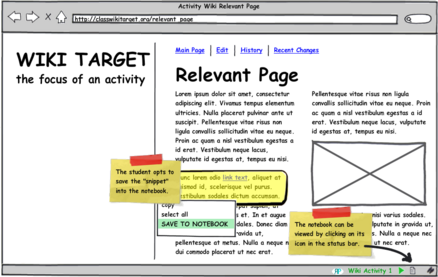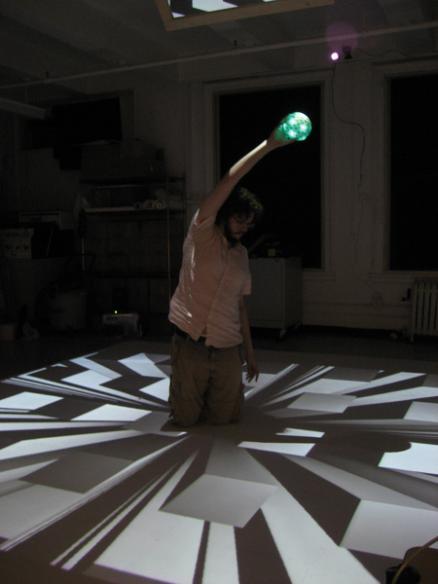interface
Quick Test of Jetpack's Select and Slidebar for Reflecting Pool
Just finished the first seminar for the Jetpack for Learning competition. I was inspired to try out a quick-and-dirty take on our "notebook" idea from the original concept. If you have Jetpack installed, drop this in the Develop editor window and try it out.
jetpack.future.import('selection');
jetpack.future.import('slideBar');
jetpack.selection.onSelection(function(){
var html = jetpack.selection.html;
jetpack.slideBar.append({
html:html,
width:300
});
});
- Mike's blog
- Comments
- Read more



- 17231 reads
Jetpack for Learning: Reflecting Pool
The internet is a potentially powerful tool for enhancing learning environments. However, the unstructured nature of it can present a challenge to both students and teachers. For example, students may lack the ability to pursue a learning goal strategically and therefore find themselves overwhelmed by the amount of information at their fingertips and wandering aimlessly. Teachers, on the other hand, may be at a loss of how to assess students' learning in such a setting and unable to understand the connections that students' are making.
 Reflecting Pool Mockup Screenshot
Reflecting Pool Mockup Screenshot
Reflecting Pool (see attached interactive PDF) aims to improve internet-based activities for students by increasing metacognitive awareness (i.e., planning, monitoring, and control of thinking) and for teachers by giving them greater access to the thought processes of their students. Furthermore, it offers a unique opportunity for all to understand and explore the collective knowledge of the class.
- Mike's blog
- Comments
- Read more



- 19883 reads
Color Mixing Game in SMALLab
We created a quick color mixing game prototype using the glowballs and some stock render engines.
The idea is to teach middle-school physics students about how combinations of light can create new colors. Players raise their glowball high or low depending on how much red, green, or blue is needed to match the color sliding down across the floor. Frantic but fun--and only about 20 to 30 minutes worth of work to put together.
- Mike's blog
- Comments
- Read more



- 7748 reads
SMALLab on the Small Screen
The positions of the glowballs, and other information coming from SCREM, can be relayed to a little Nokia N800 palmtop over the WiFi connection.
Tracking is still a little rough, and, as I mention in the video, I think the IR cams are grabbing the N800 a little bit, so we'll need to keep it outside of the area--at least until the tracker is a bit more solid. Still, it should be a handy way to bring in another interface--and other participants--inside SMALLab. In fact, I gave the N800 to James in the office, and he could watch the movements of the balls through the wall.
I'm sure that's useful somehow.
- Mike's blog
- Comments
- Read more



- 5317 reads
3D Buttons and Sliders
Here is a quick video explanation of the HitArea and DragArea render engines.
The engines can track when a pointer enters and leaves them, and the DragArea engine also reports back the pointer's relative position--handy for sliders, etc.
- Mike's blog
- Comments



- 5293 reads
More Fake 3D
Here's more work on faking three dimensions on a flat plane.
 Disco 3D: Behold the three dimensions!
Disco 3D: Behold the three dimensions!
Again, this only works from the perspective of the ball, so one person needs to hold it fairly near their point of view to get the effect. And, from the brief demo we did at the workshop, sometimes people need a few minutes to adjust to the effect before they feel like they're navigating space.
At this point, it seems like more of a fun demo or a parlor trick. One really good suggestion we got recently, though, was that we could give participants a button, say on a Wiimore, that would allow them to assume the first person perspective if more than one person is navigating the space. That might help share the experience a bit better.
- Mike's blog
- Comments
- Read more



- 4907 reads
Faking 3D on a Flat Plane
We were experimenting with different ideas for how to represent the third dimension you have access to with the SMALLab installation. This is a trial using a camera viewpoint that tracks the position of the ball as you move through a space with it. It fools you into thinking that a 3d world is changing at your feet.
It's not a perfect solution. It only works for one person, and there are limits to how high you can pretend the Z-axis goes. Still, it's an interesting way of looking at the problem, and it might open more doors later on.
- Mike's blog
- Comments
- Read more



- 5572 reads
Who Likes Pancakes?
I like pancakes. Hey, everyone likes pancakes! Check out Kyle's awesome mod of his Pancake Express game for the SMALLab installation. It's a really great test of the kind of work we can do with new Render Engines. And it's a ton of fun.
- Mike's blog
- Comments



- 4659 reads
tags
Copyright Mike Edwards 2006-2009. All content available under the Creative Commons Attribution ShareAlike license, unless otherwise noted.


